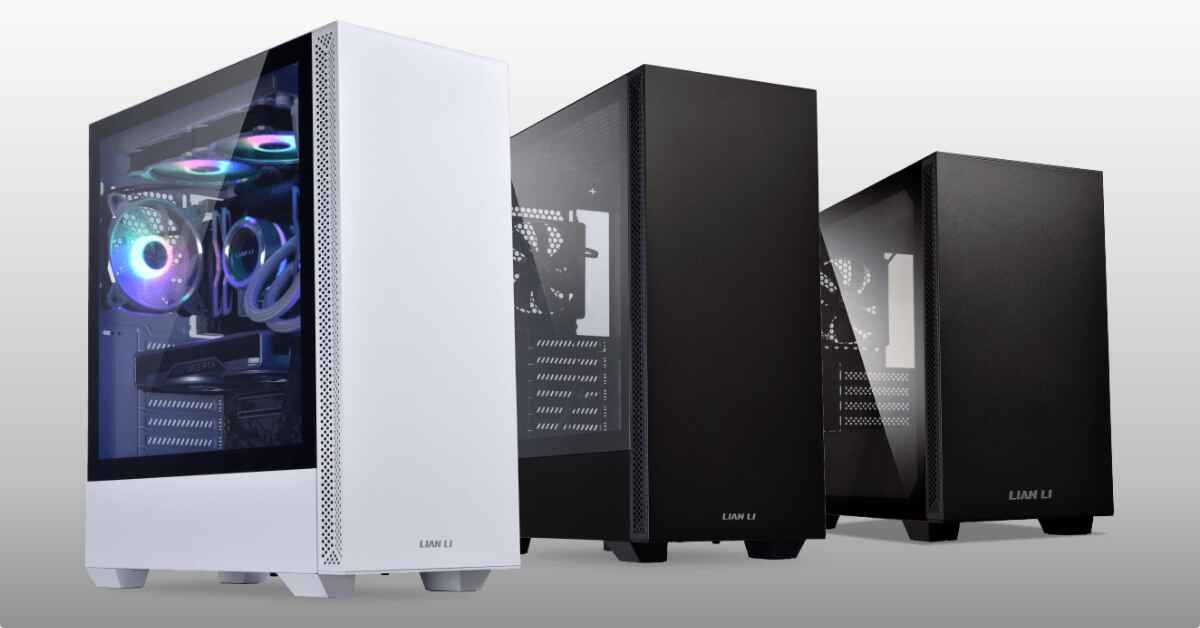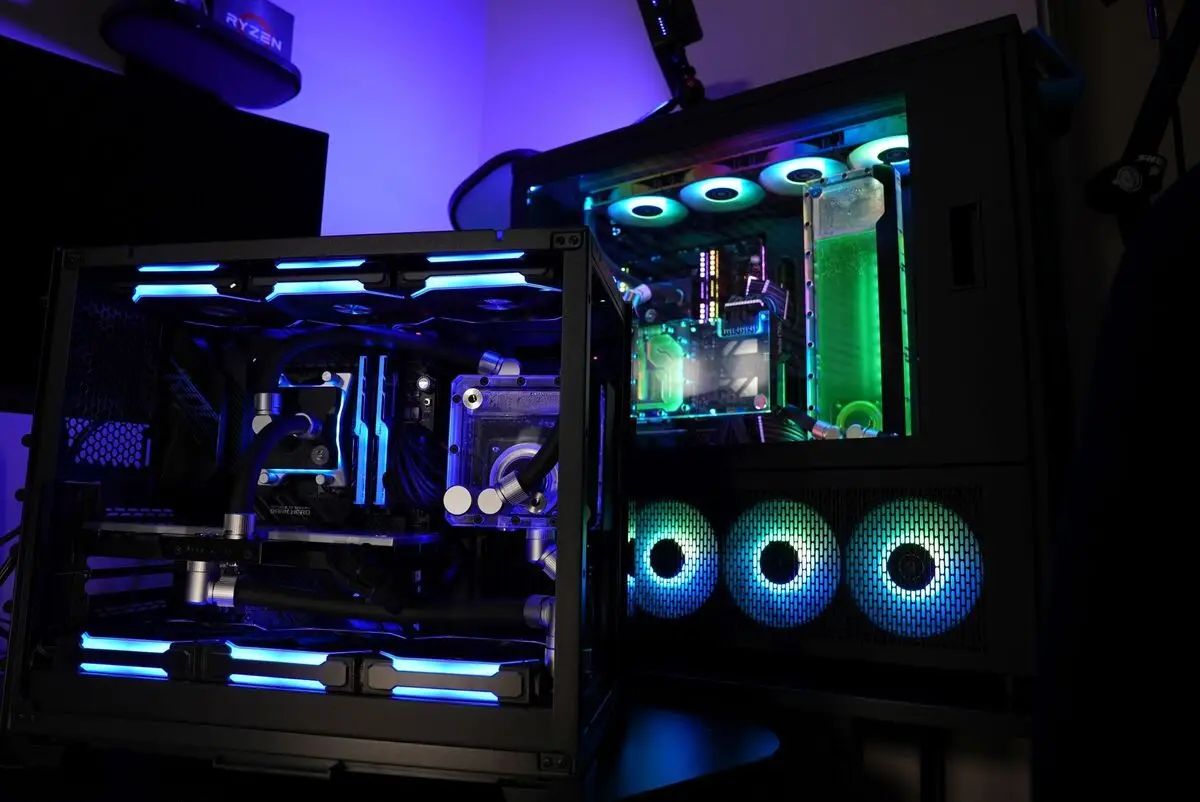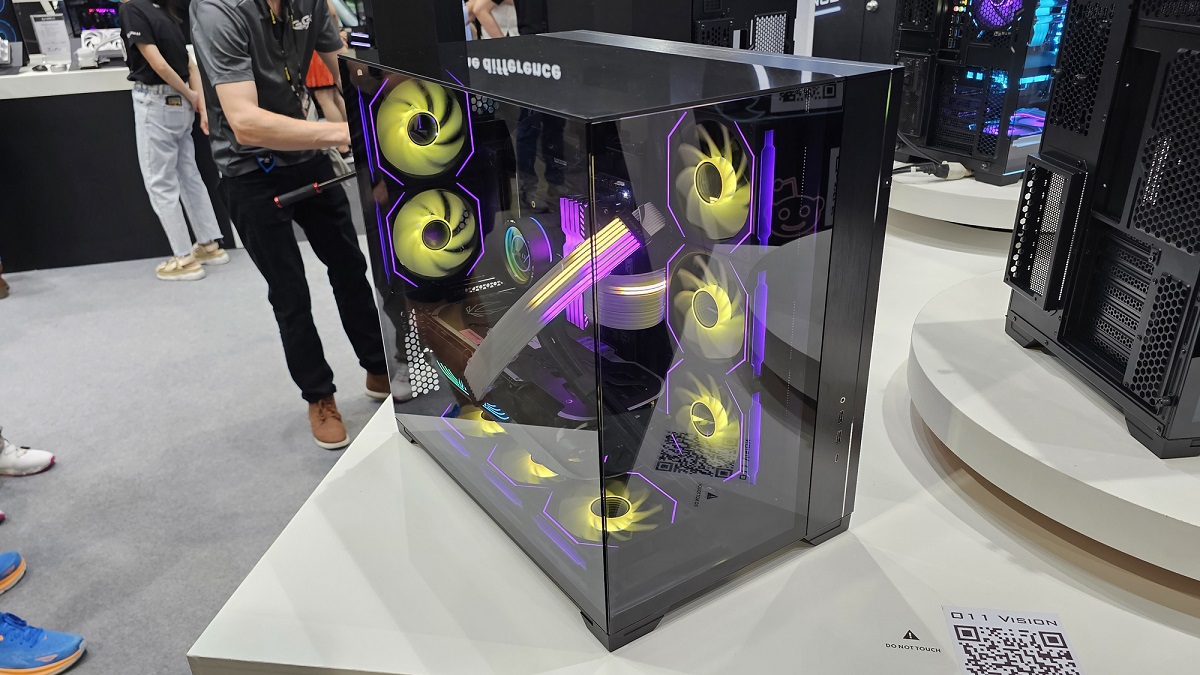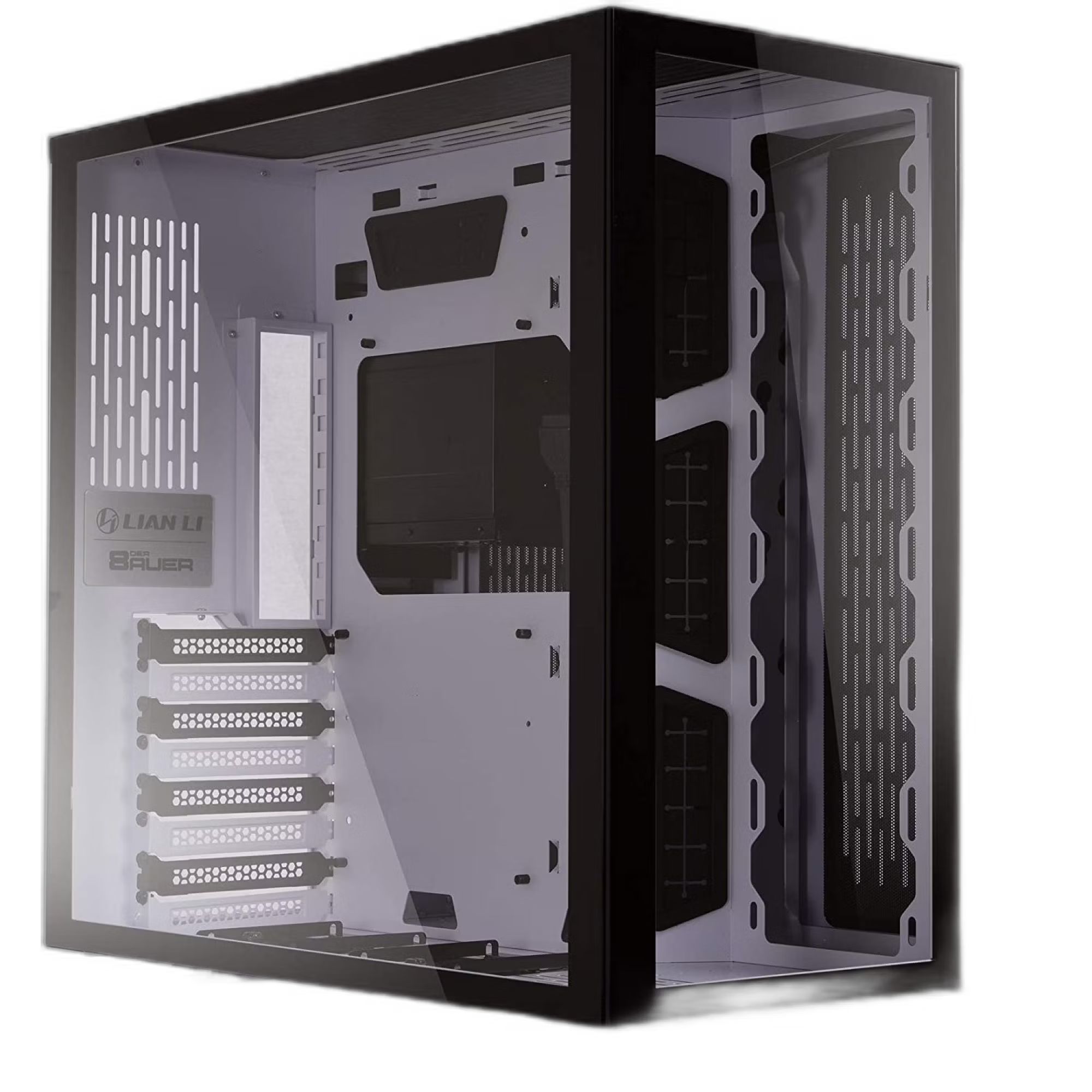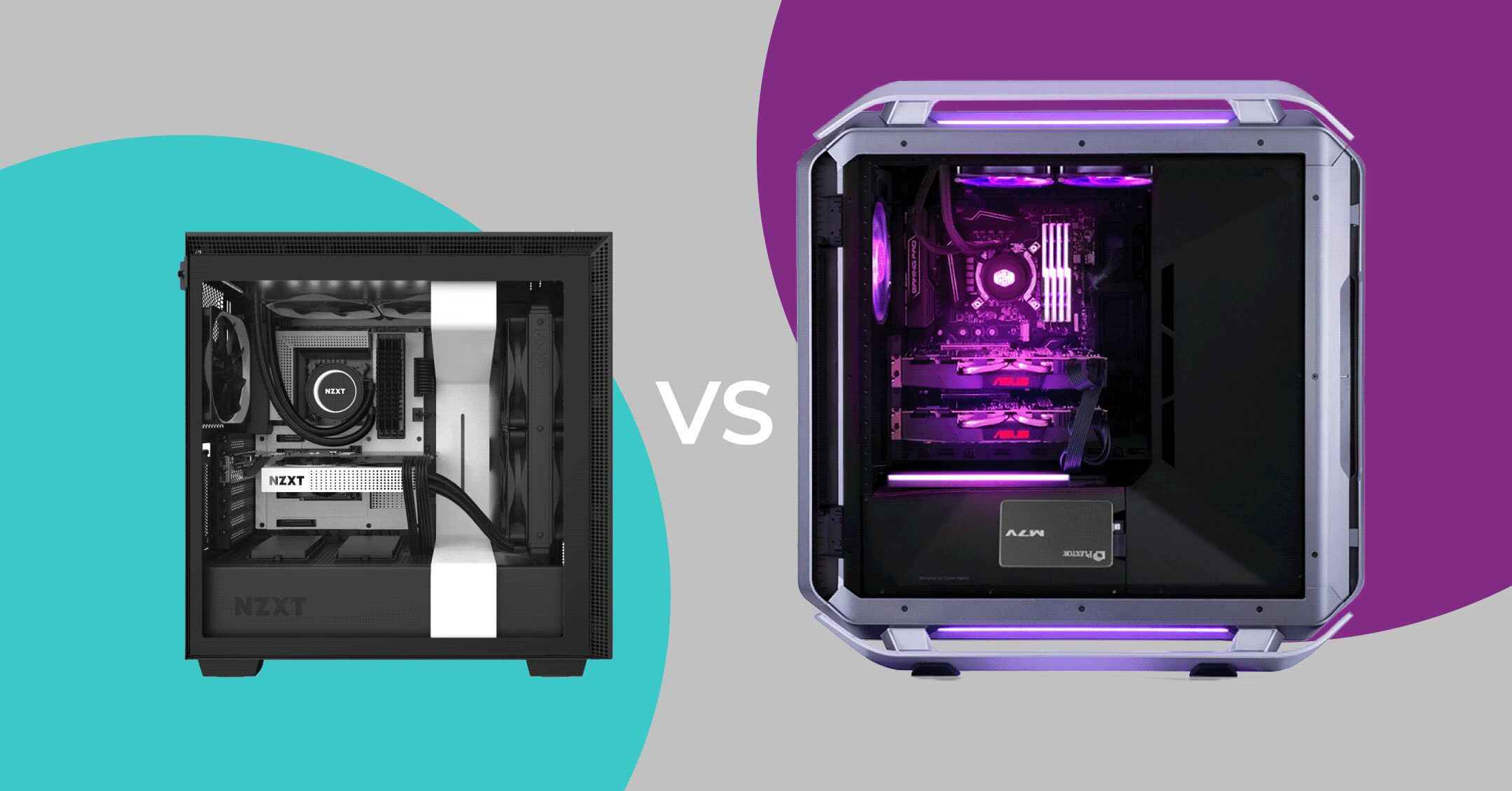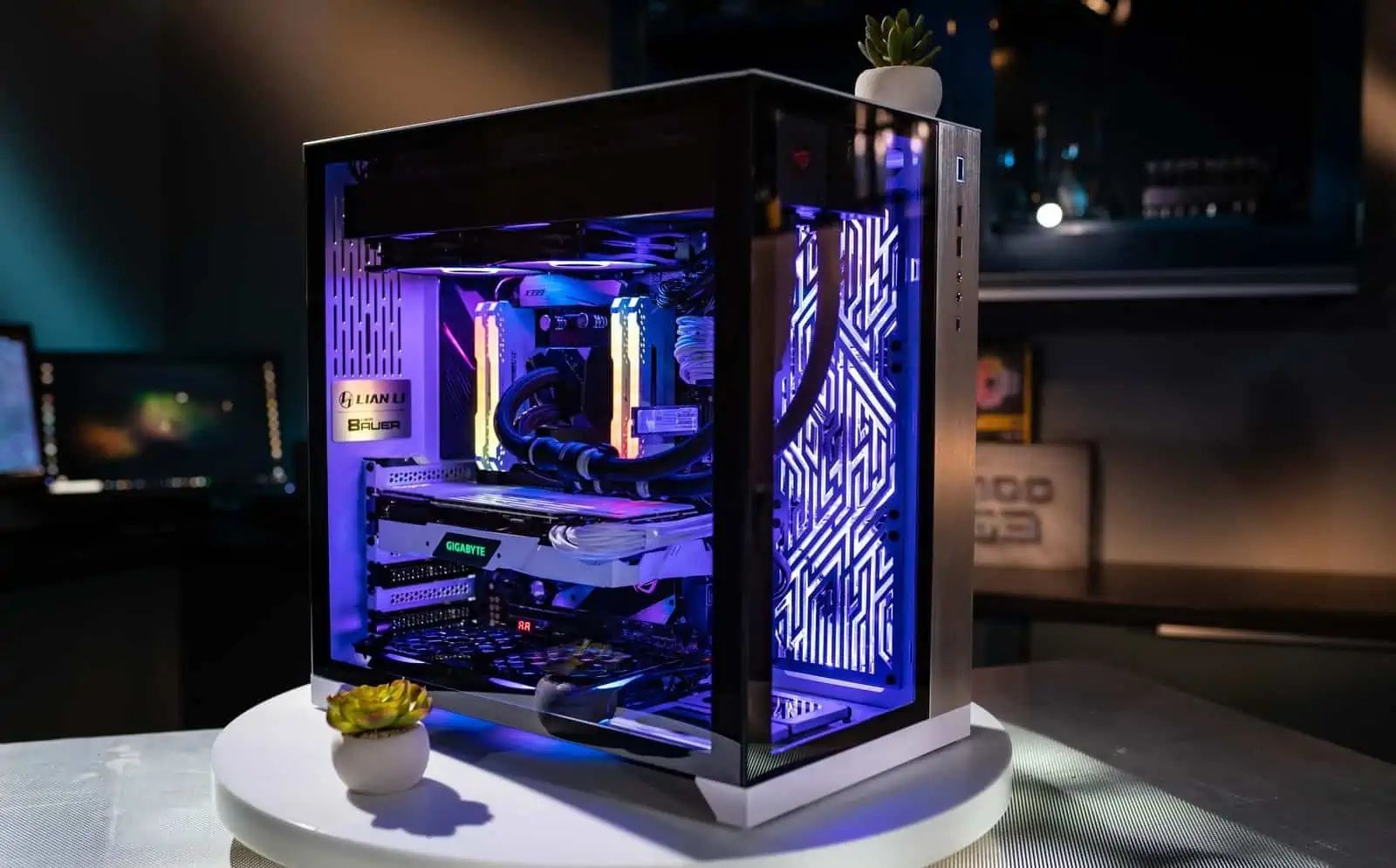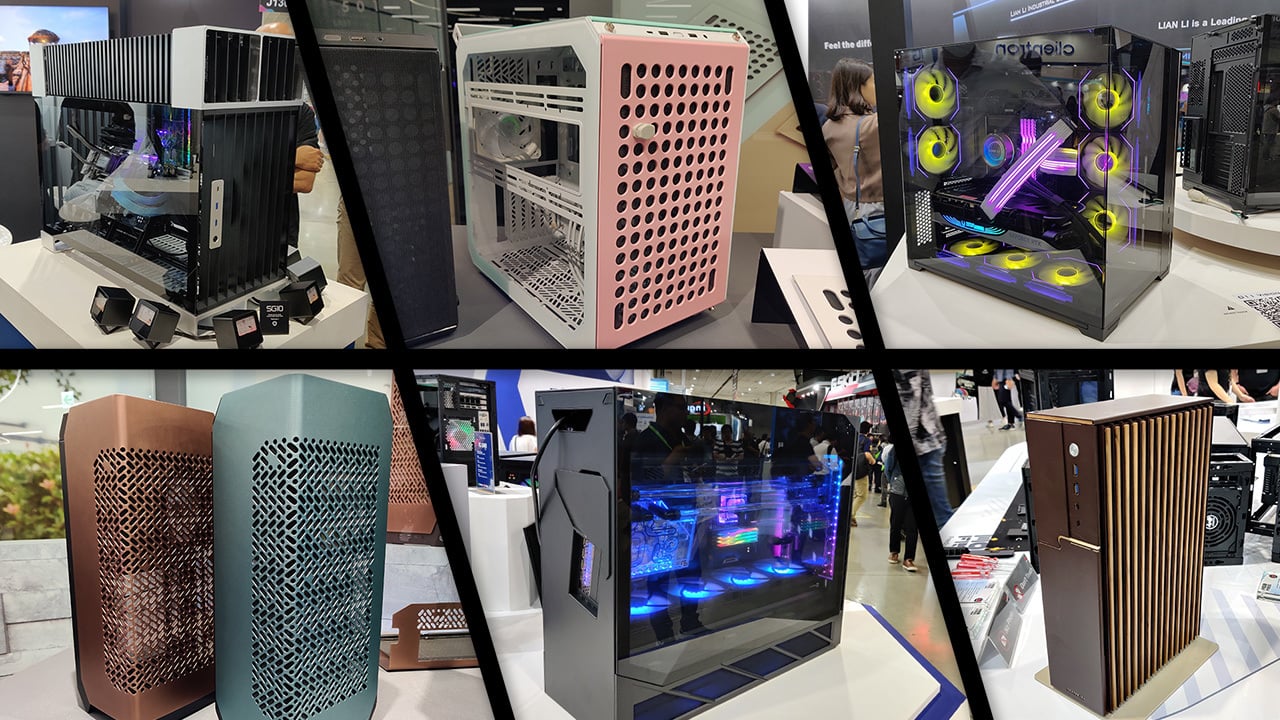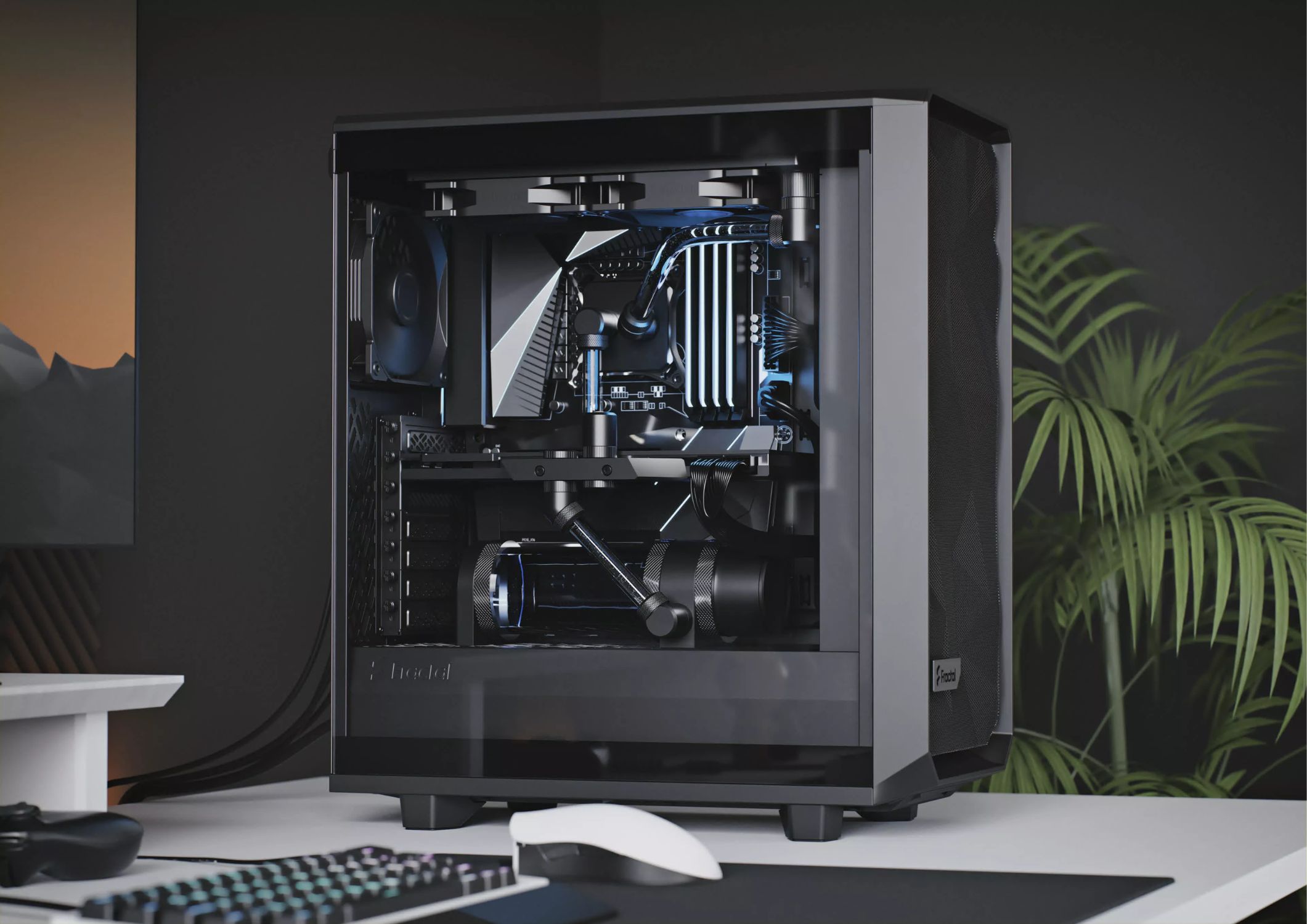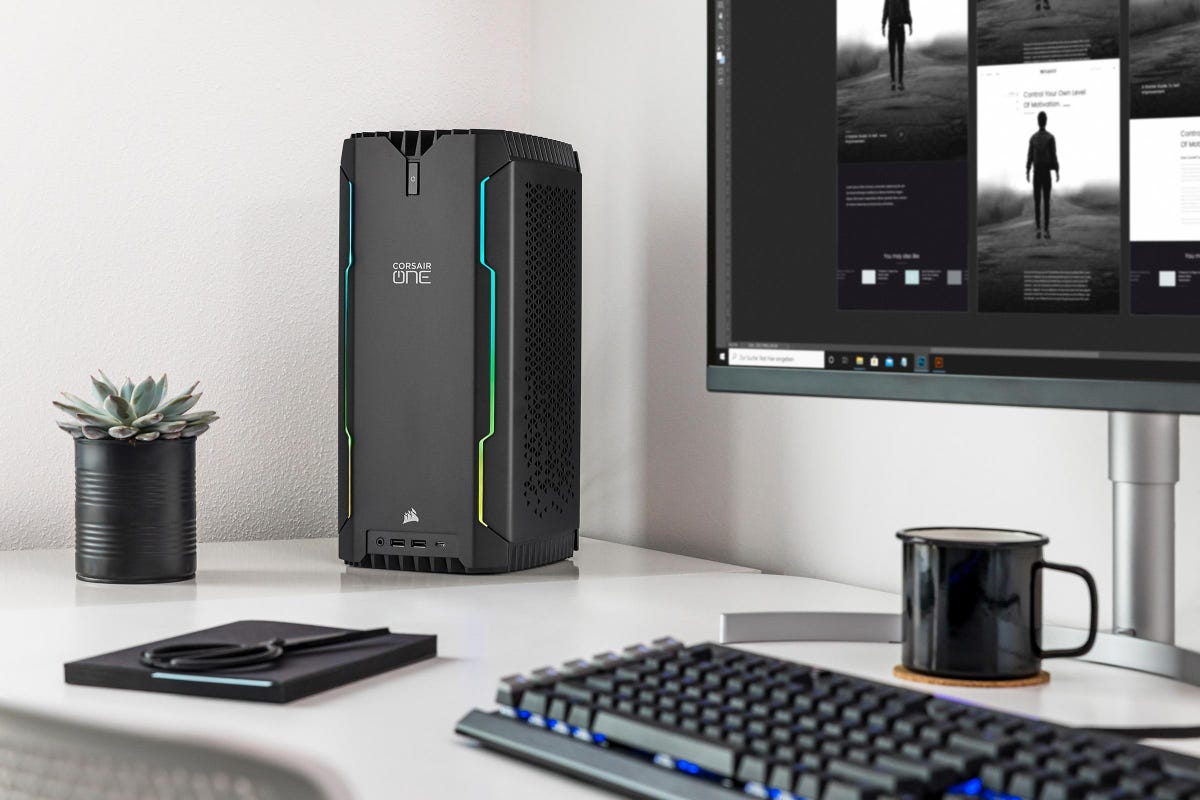Introduction
Welcome to the world of PC building, where selecting the right components for your computer is crucial. One key decision is choosing the perfect PC case that suits your needs and preferences. Two popular options that you might have come across are full tower and mid tower PC cases.
While both types serve the same purpose of housing your PC components, they differ in terms of size, features, and overall functionality. In this article, we will explore the differences between full tower and mid tower PC cases and help you determine which one is the better fit for your requirements.
When it comes to choosing a PC case, size matters. Full tower cases are known for their larger form factor, providing ample space for components and enhanced expandability. Mid tower cases, on the other hand, are more compact and fit easily into most setups without sacrificing too much in terms of functionality.
Throughout this article, we will compare full tower and mid tower cases in various aspects such as size, internal space, motherboard compatibility, cooling capacity, storage options, and more. By the end, you will have a clear understanding of the differences between these two case types and be able to make an informed decision for your PC build.
Full Tower PC Cases
Full tower PC cases are the giants of the PC case world. They are known for their spacious interiors and extensive features, making them ideal for power users and gamers who require a high level of customization and expansion options.
One of the standout features of full tower cases is their generous internal space. These cases can accommodate multiple graphics cards, large CPU coolers, and numerous storage drives without any compromise. This gives you the freedom to build a high-performance system with all the bells and whistles.
In terms of motherboard compatibility, full tower cases generally support the larger form factors like Extended ATX (E-ATX) and XL-ATX. This allows for more expansion slots and the ability to install multiple GPUs for enthusiasts who require maximum graphics power.
Cooling is another area where full tower cases excel. With the ability to house multiple case fans and radiators, these cases offer excellent airflow and cooling potential. This is especially important for those who plan to overclock their components or run high-end gaming setups that generate a lot of heat.
Furthermore, full tower cases provide ample space for storage options. You can easily fit multiple hard drives and SSDs, accommodating your growing media libraries, games, and files. Some full tower cases even offer hot-swappable drive bays for added convenience.
While full tower cases provide unmatched expandability and customization options, it’s worth mentioning that their larger size can pose challenges in terms of portability and space requirements. These cases are typically heavier and bulkier, demanding a larger desk or dedicated floor space to accommodate them.
Price-wise, full tower cases tend to be on the higher end of the spectrum compared to mid tower cases. The additional features and spaciousness come at a premium, so it’s important to consider your budget when opting for a full tower case.
In summary, full tower cases offer ample space, extensive expansion options, and excellent cooling capabilities. They are ideal for power users and gamers who require maximum customization and have ample space to accommodate these large cases.
Mid Tower PC Cases
Mid tower PC cases are the most common and widely used form factor in the PC case market. They strike a balance between size, functionality, and affordability, making them a popular choice for a wide range of users.
One of the key advantages of mid tower cases is their versatility. These cases are more compact compared to full tower cases, making them suitable for both small and medium-sized setups. They fit comfortably on most desks or floors, while still offering ample space for components.
While mid tower cases may not have as much room for expansion as full tower cases, they can still accommodate most mainstream components. They typically support ATX and Micro-ATX form factors, allowing for a decent number of expansion slots and the ability to install multiple GPUs if desired.
In terms of cooling, mid tower cases can adequately handle most setups. They generally have sufficient room for case fans and radiator installation, ensuring efficient airflow to keep your components cool. It’s important to note that if you’re planning on running an extreme overclocking setup or require a massive amount of cooling power, a full tower case might be a better option.
Storage options in mid tower cases are also quite decent. You can typically fit multiple hard drives and SSDs, allowing you to store your files, games, and media libraries without any issues. Some mid tower cases even come with clever cable management solutions to keep your build clean and organized.
Portability is another advantage of mid tower cases. They are lighter and more compact, making them easier to transport when needed. This can be particularly beneficial for users who attend LAN parties or frequently move their PC around.
One of the most significant advantages of mid tower cases is their affordability. They are generally cheaper than full tower cases, making them more accessible for users on a budget. You can still build a powerful and capable system with a mid tower case without breaking the bank.
In summary, mid tower cases provide a versatile and cost-effective solution for most PC users. They offer a good balance between size, functionality, and affordability, making them the go-to choice for many builders. Whether you’re a casual user or a budget-conscious gamer, a mid tower case can meet your needs without compromising on performance.
Size Comparison
When it comes to PC cases, size is an important factor to consider. The size of a PC case determines its dimensions, internal space, and overall compatibility with different components. Let’s compare the sizes of full tower and mid tower cases to understand their differences.
Full tower cases, as the name suggests, are the larger of the two. They typically measure around 22 to 24 inches in height, 9 to 10 inches in width, and 20 to 22 inches in depth. This larger form factor provides ample space for component installation, making it the preferred choice for users who require extensive customization and expansion options.
On the other hand, mid tower cases are more compact and have smaller dimensions. They usually measure around 16 to 18 inches in height, 7 to 8 inches in width, and 16 to 18 inches in depth. Despite their smaller size, mid tower cases still offer sufficient room for most standard components, making them a popular choice for mainstream builds.
One advantage of full tower cases is the extra headspace they provide. The larger size allows for easier cable management, improved airflow, and more room for installing larger components such as high-performance CPU coolers and multiple graphics cards. However, it’s worth noting that this increased size can also make full tower cases more challenging to fit into smaller spaces or transport when needed.
Mid tower cases, being more compact, offer a balance between size and functionality. While they may have slightly restricted internal space compared to full tower cases, they can still comfortably house most standard components. Their smaller form factor also allows for easier integration into various setups, whether it’s on a desk or in a limited space.
Ultimately, the choice between a full tower and mid tower case will depend on your specific requirements and available space. If you need maximum expandability and have ample room for a larger case, then a full tower case might be the right choice. However, if you are looking for a more compact and versatile option that fits well in most environments, a mid tower case will likely suffice.
Height
The height of a PC case is an essential dimension to consider when selecting the right case for your build. It determines the vertical space available for components and affects the overall aesthetics of your setup. Let’s delve into the height comparison between full tower and mid tower cases.
Full tower cases are known for their towering height, typically ranging from 22 to 24 inches. This extended height provides generous space for component installation, ensuring compatibility with larger motherboards, extended graphics cards, and taller CPU coolers. The extra room not only facilitates easy cable management but also enhances overall airflow within the case, promoting better cooling performance.
Mid tower cases, in contrast, have a more modest height ranging from 16 to 18 inches. While they may not offer as much vertical space as full tower cases, mid tower cases are still spacious enough to house standard-sized components comfortably. They can accommodate most mainstream motherboards, standard-length graphics cards, and CPU coolers within their compact framework.
When choosing between a full tower and mid tower case, it is crucial to consider the height required by your desired components. If you plan to incorporate multiple high-end graphics cards, opt for a full tower case to ensure sufficient clearance and prevent potential fitment issues. Additionally, if you intend to use larger aftermarket CPU coolers for enhanced cooling performance, the increased height of a full tower case will likely provide the necessary clearance.
If you are working with standard-sized components and want a more compact setup, a mid tower case will be suitable. They offer ample vertical room for most mainstream components while maintaining a manageable and more space-efficient design.
Ultimately, the height of the PC case will depend on your specific requirements and the components you plan to use. Consider the vertical space needed by your chosen motherboards, graphics cards, and CPU coolers to ensure a proper fit and to create a visually appealing build that meets your needs.
Width
The width of a PC case is an important dimension to consider as it determines the horizontal space available for component installation and affects the overall footprint of your setup. Let’s compare the width of full tower and mid tower cases to understand their differences.
Full tower cases typically have a wider form factor compared to mid tower cases. They typically measure around 9 to 10 inches in width. The extra width provides more room for component placement and cable management. This additional space is especially beneficial for users who plan on installing multiple graphics cards or larger aftermarket CPU coolers.
In contrast, mid tower cases have a more compact width, usually ranging from 7 to 8 inches. Despite their narrower profile, mid tower cases still offer sufficient room to accommodate most standard components and provide ease of installation. The reduced width makes them more space-efficient and suitable for setups with limited desk or floor space.
When deciding between a full tower and mid tower case, consider the width requirements of your components. If you plan on using multiple graphics cards or have larger CPU coolers, a full tower case with its wider width will offer more compatibility and clearance for your components. Additionally, the extra width can make cable management and accessing your components much more convenient.
On the other hand, if you are working with standard-sized components and prefer a more compact setup, a mid tower case with its narrower width will be a suitable choice. The reduced width allows for a space-saving design, making it easier to fit the case into smaller areas without sacrificing functionality.
Ultimately, the width of the PC case will depend on your specific requirements and the components you plan to use. Consider the space needed for your desired graphics cards, CPU coolers, and cable routing to ensure a proper fit and to create a clean and organized build.
Depth
The depth of a PC case is an important dimension to consider as it determines the horizontal space available for component installation and affects the overall footprint of your setup. Let’s compare the depth of full tower and mid tower cases to understand their differences.
Full tower cases are known for their deep form factor, typically measuring around 20 to 22 inches in depth. This extended depth provides ample space for component placement and cable management. The extra room allows for easier routing and hiding of cables, resulting in a cleaner and more organized build. Additionally, the increased depth provides more clearance for larger graphics cards and aftermarket CPU coolers.
In contrast, mid tower cases have a more compact depth, usually ranging from 16 to 18 inches. While they may not offer as much horizontal space as full tower cases, mid tower cases are still roomy enough to accommodate most standard-sized components. The reduced depth can make them a better fit for setups with limited desk or floor space, as they take up less room without compromising functionality.
When deciding between a full tower and mid tower case, it’s important to consider the depth requirements of your components. If you plan on using larger graphics cards or CPU coolers that require additional clearance, a full tower case with its greater depth will ensure compatibility with your desired components. Moreover, the added depth can facilitate better airflow and cooling, as it allows for improved cable management and proper spacing between components.
However, if you are working with standard-sized components and prefer a more compact and space-efficient setup, a mid tower case with its reduced depth will be a suitable choice. The shallower depth makes it easier to fit the case into smaller areas while still providing sufficient internal space for your components.
Ultimately, the depth of the PC case will depend on your specific requirements and the components you plan to use. Consider the depth needed for your graphics cards, CPU coolers, and cable management to ensure a proper fit and to create a clean and well-ventilated build.
Internal Space
The internal space of a PC case is a crucial consideration when it comes to building a computer. It determines how much room you have to work with when installing and arranging your components. Let’s compare the internal space of full tower and mid tower cases to understand their differences.
Full tower cases are the clear winners when it comes to internal space. They offer a generous amount of room to accommodate multiple components with ease. With their larger form factor, full tower cases can house multiple graphics cards, large CPU coolers, and numerous storage drives without any compromise. This is ideal for users who require extensive customization and expansion options.
On the other hand, mid tower cases provide a more modest internal space. While they may have slightly less room compared to full tower cases, mid tower cases still offer ample space to accommodate most standard-sized components. You will typically have enough space for a standard-sized motherboard, a graphics card or two, a CPU cooler, and multiple storage drives.
The internal space in both full tower and mid tower cases can vary depending on the specific model and design. It’s important to check the specifications of the case you are considering to ensure that it can accommodate all your desired components.
It’s worth noting that the larger internal space in full tower cases not only allows for more components but also makes cable management and airflow management easier. You’ll have plenty of space to route and manage cables neatly, which results in better airflow and improved cooling performance. Additionally, the spaciousness of full tower cases allows for better organization and a more visually appealing build.
Mid tower cases, while more compact, still provide enough internal room for most standard builds. They are a practical choice for users who want a balance between space-saving design and functionality. Mid tower cases often incorporate smart cable management solutions, such as grommets and tie-down points, to facilitate easy cable routing and maintain a clean interior.
Ultimately, the choice between a full tower and mid tower case for internal space will depend on your specific needs and the components you plan to use. If you require extensive customization and expansion, a full tower case would be the better choice. However, if you have more modest component requirements and want a more space-efficient design, a mid tower case will serve you well.
Motherboard Compatibility
When choosing a PC case, one of the crucial factors to consider is its compatibility with your chosen motherboard. The motherboard size plays a significant role in determining the type of case you can use. Let’s compare the motherboard compatibility of full tower and mid tower cases to understand their differences.
Full tower cases are specifically designed to accommodate larger motherboard form factors. They typically support Extended ATX (E-ATX) and XL-ATX motherboards, providing ample space for multiple expansion slots and extra features. This makes full tower cases ideal for users who require maximum expandability and want to build high-end systems with multiple graphics cards, additional PCIe devices, and extensive I/O options.
Mid tower cases, on the other hand, generally support the more common motherboard form factors such as ATX and Micro-ATX. These motherboard sizes provide a good balance between functionality and form factor, making mid tower cases a versatile choice for most users. Mid tower cases can accommodate mainstream components, including standard-sized graphics cards, multiple storage drives, and sufficient PCIe slots for most gaming and productivity needs.
It’s important to note that some mid tower cases may also offer support for the smaller Mini-ITX form factor, which is ideal for compact and minimalist builds.
When selecting a case, it’s essential to check the specific motherboard sizes supported by the manufacturer or consult the case’s specifications to ensure compatibility with your desired motherboard. This will ensure that you have the correct mounting points, I/O shield cutouts, and expansion slot availability for a seamless installation.
Ultimately, the choice between a full tower and mid tower case for motherboard compatibility will depend on the size and features of your selected motherboard. If you require a larger motherboard with more expansion slots and advanced features, a full tower case is the preferred choice. However, if you have a standard-sized motherboard and want a more compact and versatile design, a mid tower case will easily meet your needs.
Expansion Slots
Expansion slots are an essential consideration when choosing a PC case, as they determine the number of expansion cards you can install, such as graphics cards, sound cards, and other PCIe devices. Let’s compare the expansion slots of full tower and mid tower cases to understand their differences.
Full tower cases typically provide a higher number of expansion slots compared to mid tower cases. This is due to their larger form factor, which allows for more space to accommodate additional PCIe slots. Full tower cases commonly offer between seven to ten expansion slots, providing ample room for multiple graphics cards and other expansion devices.
Mid tower cases, being more compact, generally offer fewer expansion slots compared to full tower cases. Most mid tower cases have between four to seven expansion slots, which is still sufficient for most mainstream builds. This allows you to install a graphics card, sound card, and other expansion devices as needed.
The number of expansion slots you need will depend on the specific requirements of your build. If you are a gamer or content creator who will be running multiple high-performance graphics cards for gaming or video editing, a full tower case would be the better option to ensure you have enough expansion slots for all your devices.
However, if you have a standard setup with a single graphics card and fewer expansion needs, a mid tower case will provide enough expansion slots to accommodate your components.
It’s important to note that not all expansion slots are created equal. Some full tower cases may offer additional vertical or angled PCIe slots to allow for more versatile GPU configurations or specialized expansion cards. Similarly, some mid tower cases may have flexible layouts to accommodate larger graphics cards or extra-long expansion cards.
When selecting a PC case, ensure that it has the appropriate number and type of expansion slots to suit your needs. Also, consider future expansion plans to ensure you have enough room for additional cards if required.
Ultimately, the choice between a full tower and mid tower case for expansion slots will depend on your specific requirements, such as the number of graphics cards and additional expansion devices you plan to install. Consider the number of expansion slots needed to accommodate your components and choose the case that best fits your build.
Cooling Capacity
Cooling is a crucial aspect of any PC build, as it helps maintain stable and optimal performance for your components. The cooling capacity of a PC case determines its ability to dissipate heat generated by the CPU, graphics card, and other components. Let’s compare the cooling capacity of full tower and mid tower cases to understand their differences.
Full tower cases typically have a higher cooling capacity compared to mid tower cases. With their larger form factor, full tower cases can house more case fans and radiators, allowing for better airflow and heat dissipation. The extra space provides room for additional cooling solutions, making full tower cases ideal for high-end builds or users who plan to overclock their components.
Many full tower cases come with pre-installed case fans and offer support for multiple fan mounts throughout the case. This allows for efficient intake of cool air and the expulsion of hot air. Additionally, full tower cases often have ample space to mount radiators for liquid cooling systems, providing excellent cooling performance for demanding setups.
Mid tower cases, although more compact, still offer adequate cooling capabilities for most mainstream builds. They typically come with pre-installed case fans and have sufficient fan mounting points to maintain good airflow. While mid tower cases may not have the same expansion room for radiators as full tower cases, they can still accommodate liquid cooling solutions for moderate setups.
When considering cooling capacity, it’s important to evaluate the specific needs of your components. If you have high-performance CPUs or graphics cards that generate more heat, or if you plan to engage in heavy gaming or overclocking, a full tower case with its enhanced cooling capacity will ensure that your components stay within safe temperature ranges.
On the other hand, for standard or moderately demanding setups, a mid tower case will provide adequate cooling. Most mid tower cases offer excellent airflow and can efficiently handle the heat generated by mainstream components.
It’s worth noting that the cooling capacity of a case is not solely determined by its size but also by the design and layout of the case. Factors such as fan placement options, airflow management, and the availability of dust filters also contribute to the overall cooling performance.
Ultimately, the choice between a full tower and mid tower case for cooling capacity will depend on your specific requirements. Assess the heat output of your components and consider your cooling needs before selecting the most suitable case for your build.
Storage Options
Storage is an integral part of any PC build, and having ample storage options in a case is essential for accommodating your files, games, and media libraries. Let’s compare the storage options of full tower and mid tower cases to understand their differences.
Full tower cases are known for their spacious interiors, which allow for extensive storage capabilities. These cases typically offer a higher number of drive bays, including both 3.5-inch and 2.5-inch slots, to accommodate a larger number of hard drives and solid-state drives (SSDs). Full tower cases provide the flexibility to install multiple drives, making them ideal for users who require vast amounts of storage, such as content creators or media professionals.
In addition to traditional drive bays, full tower cases often feature convenient storage solutions like hot-swappable drive bays or dedicated SSD mounts. These features make it easier to swap and add storage without the need to open up the case. It’s also worth noting that full tower cases typically provide more space between the drive bays, allowing for better airflow and cable management around the storage devices.
Mid tower cases, although more compact, still provide sufficient storage options for most users. They typically offer a combination of 3.5-inch and 2.5-inch drive bays, allowing you to install multiple hard drives and SSDs. While their storage capacity may be slightly lower compared to full tower cases, mid tower cases can still accommodate your storage needs, including games, files, and multimedia content.
Some mid tower cases may also feature modular drive cages or removable drive trays, providing flexibility in configuring the storage layout according to your specific requirements. This makes it easier to install and remove drives as needed, making the storage management process more convenient.
When considering storage options, it’s crucial to determine your individual needs. If you have a vast media library, work with large video files, or require extensive storage for backups, a full tower case would be the better choice. The extra drive bays and storage options in a full tower case will provide the necessary capacity to handle your storage demands.
For users with more standard storage requirements, such as gaming and general multitasking, a mid tower case should be sufficient. Mid tower cases can accommodate a combination of hard drives and SSDs, allowing you to store your files, games, and applications effectively.
Remember to consider not only the number of drive bays but also the size of the drives you plan to use. Check the specifications of the case you are considering to ensure that it can accommodate the specific drive sizes you require.
In summary, both full tower and mid tower cases offer suitable storage options, but the choice depends on the level of storage capacity and flexibility you require for your build.
Portability and Weight
Portability is an important factor to consider when choosing a PC case, especially if you plan to move or transport your system frequently. Let’s compare the portability and weight of full tower and mid tower cases to understand their differences.
Full tower cases are generally larger and heavier than mid tower cases. Due to their spacious design and additional features, full tower cases can be bulkier and weigh more. This can make them less convenient to move around, especially if you need to transport your system to different locations or attend LAN parties.
The larger size and weight of full tower cases also mean that they require more desk or floor space. You will need to ensure that you have sufficient room to accommodate the case and that it doesn’t impede your workspace or become a burden when it comes to rearranging your setup.
Mid tower cases, on the other hand, are more compact and lightweight compared to full tower cases. These cases are designed to be more portable, making them a better choice for users who frequently move their systems or have limited space. They are easier to carry and transport, allowing for greater flexibility in setting up and adjusting your system as needed.
Mid tower cases also offer more versatility in terms of placement options. Their smaller size enables them to fit easily on most desks, while still providing ample space for components and efficient cooling. This makes them a popular choice for home users, gamers, and even professionals who require a balance between performance and mobility.
It’s worth noting that while full tower cases may be less portable, they do offer advantages in terms of expandability, customization, and high-end features. If you prioritize these aspects and don’t plan on frequently moving your system, a full tower case might still be suitable for your needs.
Ultimately, the choice between a full tower and mid tower case for portability and weight will depend on your specific requirements. Consider whether you need a case that is easier to transport and set up in various locations, or if you prioritize the additional space and features that come with a full tower case.
No matter which case you choose, ensure that you have a proper carrying or transportation solution in place, such as comfortable handles or padding, to protect your system during transit.
Price Comparison
Price is an important consideration when choosing a PC case, as it can significantly impact your overall budget for the build. Let’s compare the price ranges of full tower and mid tower cases to understand their differences.
Full tower cases tend to be higher priced compared to mid tower cases. This is largely due to their larger size, enhanced features, and expanded capabilities. Full tower cases offer more internal space, better expandability, and often come with extra features such as advanced cable management options, built-in fan controllers, and removable drive cages. These additional features contribute to the higher price point of full tower cases.
Mid tower cases, being more compact and offering a more basic set of features, are generally more cost-effective. They provide sufficient space for most standard components and offer a good balance between functionality and affordability. Mid tower cases are popular among mainstream users and gamers who are looking for a well-performing case without breaking the bank.
It’s worth noting that the price can still vary depending on the brand, build quality, and additional features offered by each case. Some mid tower cases with high-quality materials, advanced airflow designs, or unique aesthetics may have a higher price range, while some budget-friendly full tower cases may be available at a lower price point.
When considering the price, it’s important to assess your specific needs and budget for your PC build. If you require extensive customization, multi-GPU setups, or have the need for future expansion, investing in a full tower case may be worth the higher cost. Additionally, if you prioritize premium build quality, advanced features, and superior cable management options, a full tower case may provide the best value for your money.
On the other hand, if you have a more standard setup, a mid tower case will offer cost-effective options that meet your requirements without sacrificing performance or functionality. Mid tower cases are suitable for users on a budget or those who do not need extensive expansion options.
It’s essential to strike a balance between your budget and the features you need when selecting a PC case. Research and compare prices, read reviews, and consider the long-term benefits and performance you will gain from your chosen case.
Whether you opt for a full tower or mid tower case, it’s important to choose a well-built case that suits your needs and offers the best value for your budget.
Conclusion
Choosing the right PC case is a crucial decision when building your computer. Full tower and mid tower cases each offer their own set of benefits and considerations. Let’s summarize the key points we discussed throughout this article.
Full tower cases provide expansive internal space, extensive expandability, and superior cooling capabilities. They are ideal for power users and gamers who require maximum customization and have ample room to accommodate these large cases. Full tower cases offer more storage options, additional expansion slots, and advanced features that come with a higher price tag. However, their larger size can limit portability and space requirements, so consider your available desk or floor space.
Mid tower cases strike a balance between size, functionality, and affordability. They are suitable for most mainstream builds, offering sufficient room for standard-sized components and efficient cooling. With a more compact and lightweight design, mid tower cases are easier to transport and fit into smaller spaces. They are cost-effective options that still provide the necessary features for a well-performing system.
The choice between a full tower and mid tower case ultimately depends on your specific needs, budget, and available space. Assess your requirements for internal space, motherboard compatibility, expansion slots, cooling capacity, storage options, portability, and price. Consider the components you plan to use and the level of customization or expansion you desire for your build.
For users who require extensive customization, multiple graphics cards, and advanced cooling solutions, a full tower case may be the better choice. On the other hand, if you have a standard-sized build, prefer a more compact design, and want a balance between performance and affordability, a mid tower case will likely suit your needs.
Remember to do thorough research, read reviews, and consider the specific features and specifications of the cases you are considering. By carefully evaluating your needs and comparing the options, you can select the perfect PC case that will provide a solid foundation for your computer build and satisfy your requirements for years to come.







